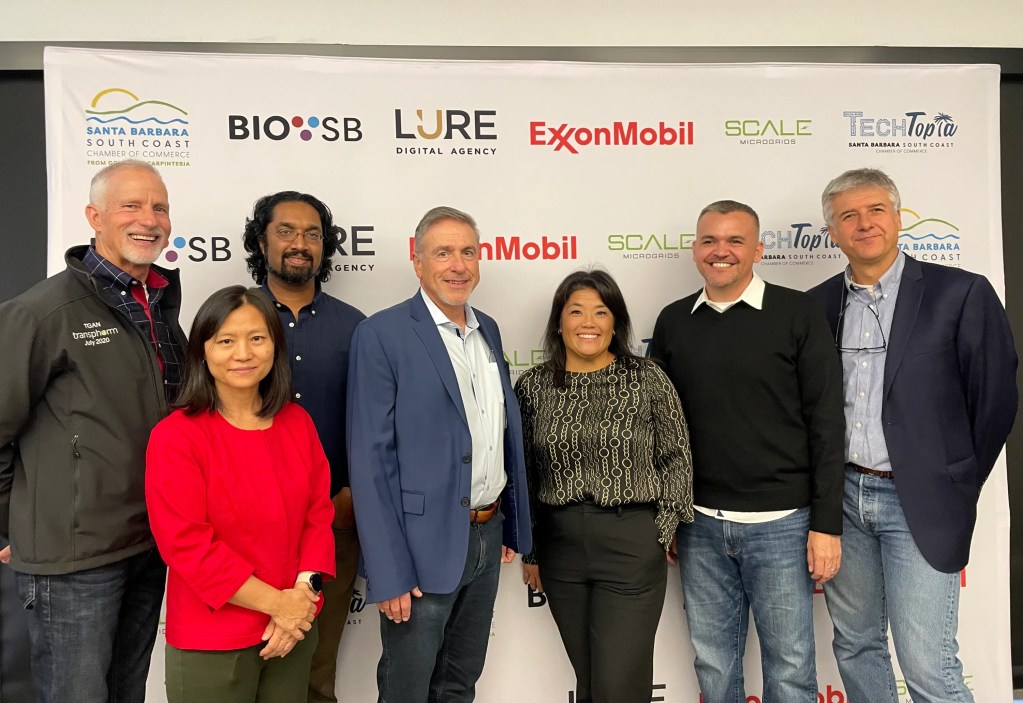On November 15, the Santa Barbara South Coast Chamber of Commerce hosted TechTopia, where leaders from six local tech companies discussed what led their companies to choose the South Coast for their operations and the challenges posed by an unreliable electric grid, worker shortages, and high housing costs.
Held at LinkedIn’s facility in Carpinteria, Chamber Board Chair and LinkedIn Head of Nonprofit Strategy & Sales Joey Zumaya welcomed guests and served as moderator. Chamber President and CEO Kristen Miller acknowledged the “laid back braniacs” in the room who enthusiastically serve on Chamber committees to make sure this area is an inviting and vibrant place for innovative companies.
Google Hardware Engineer Paula Heu explained that for Google’s Goleta facility, where it develops quantum chips, Santa Barbara was the perfect site because of UCSB’s NanoFab, the quality of life here, and the awesome talent in quantum, physics, and quantum physics coming out of UCSB.
The NanoFab is an environmentally controlled room to make semiconductors that UCSB rents out to businesses. She praised this facility as a great asset for start ups that don’t have the capital to create their own facility. Google is still using the NanoFab for new materials, but now has its own facility where its production is faster and it will be hiring a lot more people for this operation.
Kyocera SLD Laser Supply Chain Director Marco Scussat related that his company was also drawn to the area by the NanoFab and the talent pool coming out of UCSB.
Turning to the challenges, Agilent Technologies Associate Vice President Larry Doris lamented the 17 electricity interruptions Agilent has experienced in the past two years, each one necessitating a controlled shut down and a delay for its time-sensitive cancer diagnostic services. More broadly, he asserted, the unreliability impacts the competitiveness of the region in attracting new businesses.
Doris is working through the Chamber to bring together stakeholders, including utilities, government agencies, and businesses, to create more power resiliency. The focus, according to Doris, needs to be not at the macro level, but at the end-user site.
Transphorm Human Resource Leader Randy Berg related the challenges his wafer processing operations experience with outages and noted that there are many other wafer processing companies here similarly affected. While someone in an office may not even notice a power surge, Berg noted, it can ruin $40,000 worth of product for Transphorm. While Tesla battery packs are an alternative for an established business, they are not for a start up.
As for workforce development, Zumaya offered some interesting data from LinkedIn. In the TriCounty area, LinkedIn has 658,000 profiles and businesses offering roughly 15,000 jobs. Measured by the volume of emails recruiters send to people trying to fill jobs, the tech sector already is by far the hardest to hire in, and tech is projected to be among the fastest growing industries here. Noting that there are 4,071 profiles with the title president, CEO, or founder, Zumaya observed that tech companies can land here, but it’s an open question whether they can expand here.
UCSB NanoFab Process Group Manager Demis John emphasized that the lack of visibility of the local tech sector prevents youth who have the ability and would love working in this sector from taking the classes and getting into the programs needed to prepare them for good jobs here.
A relatively new program brings SBCC students into a clean room at UCSB (not the NanoFab), where in the course of just one week, they make two chips. This hands-on experience exposes the students to jobs and an industry they didn’t even know existed here and shows them that they have the ability to do the work. Demis concedes that not everyone wants to make chips, but for those who do, this program exposes them to a career that can enable them to stay here and make a good living. This is especially valuable, Demis noted, given the shortage of workers in the field.
The Chamber itself, Demis related, is building a concerted effort to address the workforce challenge, working to connect the different segments — high schools, SBCC, UCSB, and companies.
On the housing front, Zumaya pointed to a Chamber-led effort to create an employer-sponsored housing consortium which would allow employers to secure housing for employees without the administrative burden of managing the units.
Curvature General Manager of the Global Hardware Division Sachi Thompson called the housing situation a crisis. She noted the success of Cottage Health, Sansum, and UCSB with workforce housing and emphasized the need for businesses to come together. Noting that companies already provide some relocation assistance, Thompson suggested bridge housing may be a starting point.
Berg closed out the session, urging companies to work together through the Chamber to solve these pressing challenges.
For workforce development, the Chamber seeks to bridge the gap between industry leaders, educational institutions, job seekers, and others through the formation of an industry-education workforce development roundtable that would develop training programs.
For the housing consortium effort the Chamber is leading, employers would be able to acquire residential properties or lease units from new housing projects based on their level of investment in the consortium.

